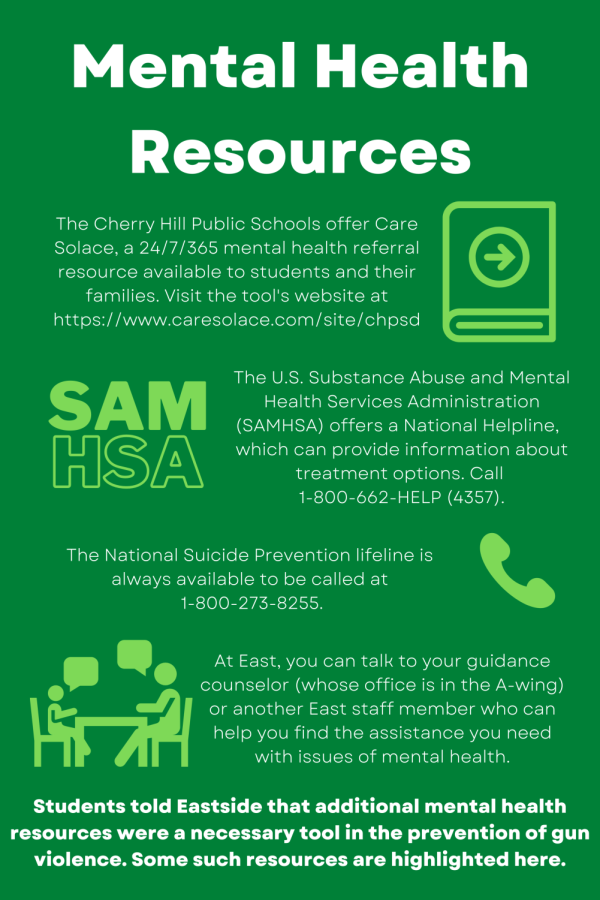How does mental health factor into school shootings?
February 27, 2022
Cherry Hill East and other mental health organizations has made sure to make their resources available for anyone who is seeking help.
Surprisingly, in the midst of the COVID-19 pandemic, gun related violence has increased significantly as compared to past years. This is especially true in certain major cities such as Los Angeles, Chicago, and Baltimore. The American Journal of Emergency Medicine offers some explanations, such as that of people experiencing financial crisis from unemployment, the increased sale and consumption of alcohol, and increased firearm purchases. What impacts does this have? Specifically, how does this national crisis impact educators and children in U.S. schools? Well, in the United States of America, school shooting drills have sadly become very common. With these drills come significant anxiety and fear. Not only are parents terrified of the unspeakable happening, but students are being affected in damaging ways as well.
It is hard to ignore that the precautions that schools take to protect their students can cultivate worry and anxiety in students, especially when schools conduct active-shooter drills and lockdowns. According to the Child Mind Institute at Palouse River Counseling, more and more schools are conducting these drills, but schools that “try to make the drills as realistic as possible risk scaring students (and teachers,) and miss the point of these drills in the first place.” The institute suggests that teachers who talk about active shooters should do so with confidence and should ensure that their students know that the school will take necessary precautions to protect their students’ safety.
Another factor that contributes to the uneasiness that U.S. students may feel coming to school is the way shootings are covered on television and social media. The way in which tragedy is displayed is certainly quite intense. Media coverage can dominate the minds of parents, and children can then sense their parents worry, leading them to feel afraid themselves.
According to a survey conducted by the Pew Research Center, 25% of U.S. teenagers claim that they are very worried, and 32% say they are somewhat worried, about a shooting occurring at their school. These percentages amount to more than half of U.S. teens, which is very concerning to say the least. It is also apparent that some students view mental illness checks, weapon bans, and metal detectors in schools as effective ways to implement safety measures. Most teens do not support the gun lobby’s efforts to allow students and staff in colleges and universities to carry guns because this could potentially lead to accidents and create an apprehensive environment that would not feel safe despite opposite intentions.
This begs another question: how likely is it for students to bring an armed weapon to school? There are many instances in which a gun can be found in a student’s possession at school, such as for a kid to show off to friends or for protection and in case of a fight breaking out. However, kids may not really understand the implications of bringing a weapon, and many states in the U.S. do not require parents to keep their guns in a secure place. Students can get expelled or even arrested for being caught with a weapon. The Centers for Disease Control (CDC) say that 5.4% of teens in the U.S. have been caught with a weapon. Therefore, schools must be vigilant, especially when it comes to kids who potentially could act in violence. Instability at home, having parents in the military, and being bullied at school are also factors that can contribute to the percentage of kids bringing guns to school. Victims of bullying are twice as likely to bring weapons to school than those who are not bullied, according to the CDC. However, it is important to mention that researchers claim that if a student’s safety is not being endangered, they are very unlikely to bring a gun to school, despite being a victim of bullying or harassment at school. Students that experience physical threats numerous times are more likely to want to act out violently or ensure protection at school through firearm possession.
To avoid this, U.S. schools should focus more on making sure that all students feel safe. The U.S. must break this pattern of students fearing for their own safety in order to decrease the likelihood of students creating dangerous situations with weapons at school. Student mental health and safety should be prioritized above all else.
